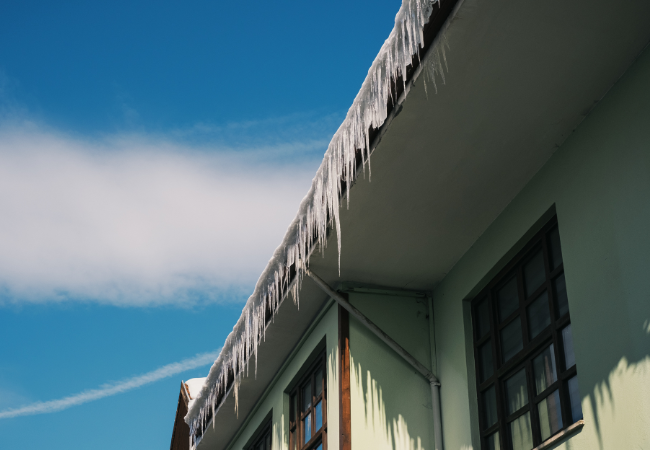How Snow And Ice Impact Different Types Of Roofing Shingles
Roof Right: Exterior Home Remodeling Specialists in Maryland Contact UsSchedule A Free EstimateWinter in Maryland brings beautiful snow-covered landscapes, but it also brings challenges for homeowners—especially when it comes to their roofs. Snow and ice can cause significant wear and tear on roofing materials, leading to leaks, structural damage, and costly repairs if not properly addressed. Understanding how different types of roofing shingles react to harsh winter weather can help homeowners make informed decisions about maintenance, repairs, and even roof replacements. Each type of roofing material has unique strengths and weaknesses when it comes to handling the freezing temperatures, heavy snow accumulation, and ice buildup that winter brings. Asphalt shingles, metal roofing, wood shakes, and composite shingles all respond differently to the elements, and knowing what to expect can help you protect your investment. In this article, we’ll explore how snow and ice impact different types of roofing shingles and what Maryland homeowners can do to minimize winter-related damage.
Answering The Question: How Snow And Ice Impact Different Types Of Roofing Shingles?
Asphalt Shingles and Winter Weather
Asphalt shingles are the most common roofing material used in Maryland due to their affordability and durability. However, while they can withstand moderate snowfall and ice accumulation, they are not immune to winter damage. One of the biggest issues with asphalt shingles is their vulnerability to ice dams. When warm air from your attic melts snow on the roof, the water flows down toward the eaves, where it refreezes and creates an ice dam. As more snow melts, the trapped water can seep under the shingles, leading to leaks and water damage inside your home. Additionally, the freeze-thaw cycle can cause asphalt shingles to become brittle over time. If water gets beneath a shingle and then freezes, it expands, pushing the shingle up and weakening its seal. This can cause curling, cracking, and premature aging of the shingles. Proper attic insulation and ventilation can help mitigate this issue by regulating roof temperatures and preventing ice dams from forming.
Metal Roofing and Snow Shedding
Metal roofing is known for its durability and ability to withstand harsh weather conditions, making it an excellent choice for Maryland homeowners dealing with winter storms. One of the biggest advantages of metal roofing is its ability to shed snow quickly. Because metal roofs are smooth and non-porous, snow and ice slide off rather than accumulating and causing excessive weight. However, while this is generally a benefit, it can also pose a safety risk. Large sheets of snow and ice can suddenly slide off the roof, potentially damaging gutters, vehicles, or anything in the fall zone. To prevent this, homeowners can install snow guards or rails, which help control the movement of snow and prevent sudden avalanches. Another consideration with metal roofing is its ability to expand and contract in fluctuating temperatures. While this doesn’t usually cause damage, it can lead to minor shifting of the panels over time. Fortunately, proper installation with expansion gaps can mitigate this issue and ensure long-term durability.
Wood Shake Shingles and Moisture Retention
Wood shake shingles offer a beautiful, natural aesthetic, but they require extra care during the winter months. One of the biggest concerns with wood shakes is their tendency to absorb moisture. When snow and ice sit on the roof, water can seep into the wood, leading to swelling, warping, and potential rot. Repeated freezing and thawing can also cause cracks to form in the wood, which weakens the shingles and reduces their lifespan. Additionally, excessive moisture retention can promote the growth of mold, mildew, and algae, further damaging the wood. To protect wood shake shingles from winter damage, homeowners should ensure their roofs are properly treated with sealants and maintained regularly. Keeping gutters clean and clear can also prevent water from backing up onto the shingles and causing excess moisture exposure.
Slate Roofing and Heavy Snow Load
Slate roofing is one of the most durable roofing materials available, known for its long lifespan and resistance to extreme weather conditions. However, while slate is exceptionally strong, it is also quite heavy. This means that excessive snow accumulation can add significant weight to the roof, potentially stressing the structure underneath. Additionally, ice can form in the small gaps between slate tiles, expanding and creating pressure that can cause cracking or breakage. If a slate tile is damaged, it must be replaced carefully, as improper handling can lead to further damage. To prevent problems with slate roofing in winter, homeowners should ensure their roofs are regularly inspected for weak spots or loose tiles. Having a professional remove excess snow buildup can also prevent unnecessary stress on the roof’s structure.
Composite and Synthetic Shingles
Composite and synthetic shingles are designed to mimic the look of natural materials like wood, slate, or asphalt while offering superior durability. These roofing materials are often more resistant to weather-related wear and tear, making them a good option for Maryland homeowners who want long-lasting performance during the winter. Many composite shingles are engineered with impact-resistant technology, which makes them less likely to crack or break under the weight of ice and snow. Additionally, they tend to have better water resistance, reducing the risk of moisture-related issues like mold growth and rot. However, while composite shingles offer improved durability, they still require proper maintenance. Ensuring adequate ventilation, sealing potential entry points for water, and keeping gutters clear will help extend the lifespan of composite shingles in winter conditions.
How to Protect Your Roof from Winter Damage
While different roofing materials react to snow and ice in various ways, there are universal steps Maryland homeowners can take to protect their roofs during the winter months.
- Keep Gutters Clean – Clearing leaves, debris, and ice from your gutters ensures proper drainage and prevents ice dams from forming.
- Inspect Your Roof Before Winter – Scheduling a professional inspection before the cold weather sets in allows you to identify potential weak spots and address them before they become major problems.
- Improve Attic Ventilation – Proper attic insulation and ventilation help regulate roof temperature, reducing the likelihood of ice dams and condensation-related damage.
- Remove Excess Snow – Using a roof rake to remove heavy snow buildup can prevent structural stress and minimize the risk of leaks.
- Repair Any Existing Damage – Cracked or missing shingles should be repaired before winter to prevent water infiltration and further deterioration.
Contact Roof Right For Roof Repair Services In Maryland
Winter weather in Maryland can be tough on your roof, but with the right precautions and maintenance, you can minimize the risk of snow and ice-related damage. Whether you have asphalt shingles, metal roofing, wood shakes, or slate tiles, understanding how your roofing material responds to winter conditions can help you take the necessary steps to protect your home. At Roof Right, we specialize in roofing repairs, maintenance, and replacements to keep your home safe throughout the seasons. If you’ve noticed signs of winter damage, ice dams, or leaks in your roof, don’t wait until the problem gets worse. Contact us today to schedule an inspection and ensure your roof is in top condition for the cold months ahead. Let Roof Right help protect your home from winter’s harsh elements!
Areas We Serve
If you're looking for a roof contractor in Maryland, give Roof Right a call today at (410)-374-5923 to schedule an appointment!
Carroll County
Howard County
Clarksville, Columbia, Elkridge, Ellicott City, Fulton, Jessup, Laurel, Woodstock
Montgomery County
Baltimore County
Baldwin, Bradshaw, Carney, Cockeysville, Glen Arm, Hunt Valley, Jacksonville, Kingsville, Lutherville, Nottingham, Overlea, Owings Mills, Parkton, Parkville, Perry Hall, Phoenix, Pikesville, Reisterstown, Sparks, Timonium, Towson, White Marsh

